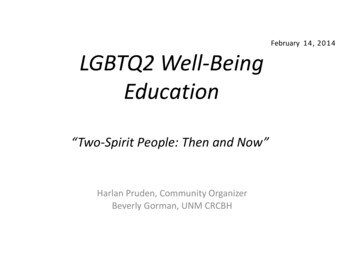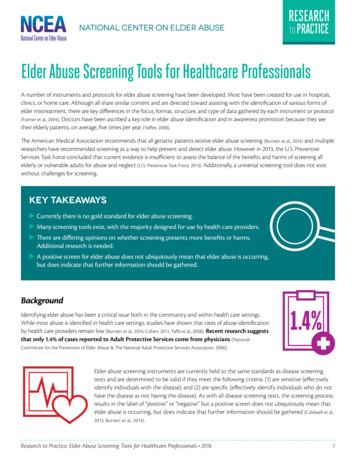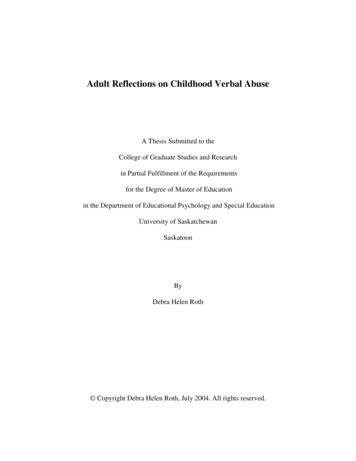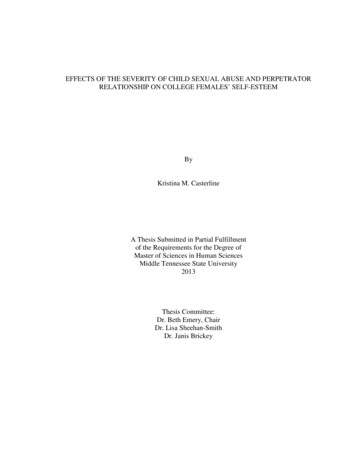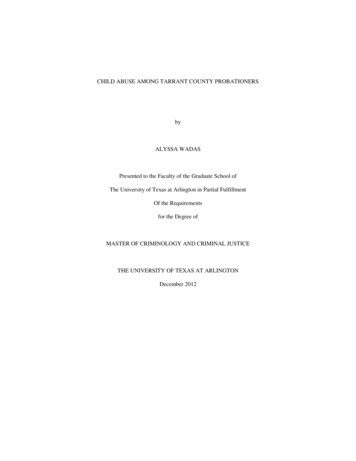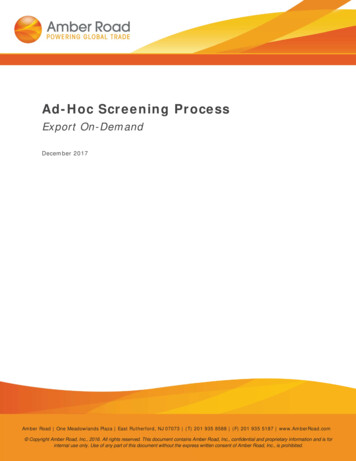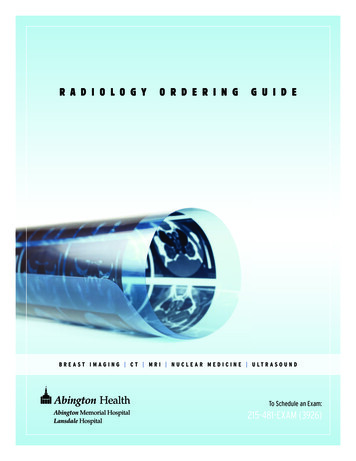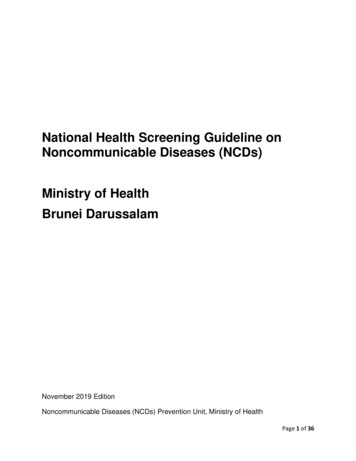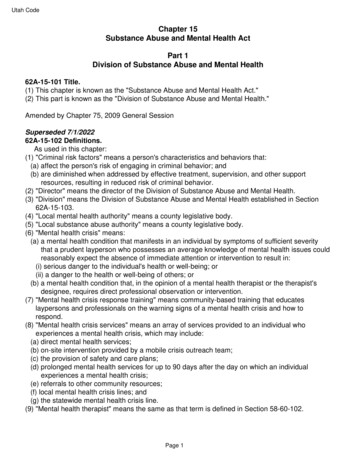
Transcription
March 2005Nursing Best Practice GuidelineShaping the future of NursingWoman Abuse: Screening,Identification and Initial Response
Greetings from Doris GrinspunExecutive DirectorRegistered Nurses’ Association of OntarioIt is with great excitement that the Registered Nurses’ Association of Ontario (RNAO)disseminates this nursing best practice guideline to you. Evidence-based practice supportsthe excellence in service that nurses are committed to deliver in our day-to-day practice.We offer our endless thanks to the many institutions and individuals that are makingRNAO’s vision for Nursing Best Practice Guidelines (NBPGs) a reality. The Governmentof Ontario recognized RNAO’s ability to lead this program and is providing multi-year funding. TazimVirani, NBPG program director, with her fearless determination and skills, is moving the programforward faster and stronger than ever imagined. The nursing community, with its commitment andpassion for excellence in nursing care, is providing the knowledge and countless hours essential to thecreation and evaluation of each guideline. Employers have responded enthusiastically to the request forproposals (RFP), and are opening their organizations to pilot test the NBPGs.Now comes the true test in this phenomenal journey: Will nurses utilize the guidelines in theirday-to-day practice?Successful uptake of these NBPGs requires a concerted effort of four groups: nurses themselves, otherhealthcare colleagues, nurse educators in academic and practice settings, and employers. After lodgingthese guidelines into their minds and hearts, knowledgeable and skillful nurses and nursing studentsneed healthy and supportive work environments to help bring these guidelines to life.We ask that you share this NBPG, and others, with members of the interdisciplinary team. There is muchto learn from one another. Together, we can ensure that Ontarians receive the best possible care everytime they come in contact with us. Let’s make them the real winners of this important effort!RNAO will continue to work hard at developing and evaluating future guidelines. We wish you the bestfor a successful implementation!Doris Grinspun, RN, MSN, PhD(cand), OOntExecutive DirectorRegistered Nurses’ Association of Ontario
Nursing Best Practice GuidelineHow to Use this DocumentThis nursing best practice guideline is a comprehensive document providing resourcesnecessary for the support of evidence-based nursing practice. The document needs to be reviewed andapplied, based on the specific needs of the organization or practice setting/environment, as well as theneeds and wishes of the client. Guidelines should not be applied in a “cookbook” fashion but used as atool to assist in decision making for individualized client care, as well as ensuring that appropriatestructures and supports are in place to provide the best possible care.Nurses, other health care professionals and administrators who are leading and facilitating practicechanges will find this document valuable for the development of policies, procedures, protocols,educational programs, assessment and documentation tools, etc. It is recommended that the nursingbest practice guidelines be used as a resource tool. Nurses providing direct client care will benefit fromreviewing the recommendations, the evidence in support of the recommendations and the processthat was used to develop the guidelines. However, it is highly recommended that practicesettings/environments adapt these guidelines in formats that would be user-friendly for daily use. Thisguideline has some suggested formats for such local adaptation and tailoring.Organizations wishing to use the guideline may decide to do so in a number of ways: Assess current nursing and health care practices using the recommendations in the guideline. Identify recommendations that will address identified needs or gaps in current services. Systematically develop a plan to implement the recommendations using associatedtools and resources.RNAO is interested in hearing how you have implemented this guideline. Please contact us to share yourstory. Implementation resources will be made available through the RNAO website to assist individualsand organizations to implement best practice guidelines.1
Woman Abuse: Screening, Identification and Initial ResponseWoman Abuse: Screening,Identification and Initial ResponseProgram Team:Tazim Virani, RN, MScN, PhD(candidate)Program DirectorJane M. Schouten, RN, BScN, MBAProgram CoordinatorHeather McConnell, RN, BScN, MA(Ed)Program ManagerStephanie Lappan-Gracon, RN, MNProgram Coordinator – Best Practice Champions NetworkJosephine Santos, RN, MNProgram CoordinatorBonnie Russell, BJProgram AssistantCarrie ScottAdministrative AssistantJulie BurrisAdministrative AssistantKeith Powell, BA, AITWeb EditorRegistered Nurses’ Association of OntarioNursing Best Practice Guidelines Program111 Richmond Street West, Suite 1100Toronto, Ontario M5H 2G4Website: www.rnao.org/bestpractices2
Nursing Best Practice GuidelineDevelopment Panel MembersDaina Mueller, RN, BScN, MSNSarah Kaplan, MSWTeam LeaderProgram ManagerHamilton Public Health andCommunity Services DepartmentHamilton, OntarioCoordinatorPartner Abuse Sexual Assault Care TeamCornwall Community HospitalCornwall, OntarioDebbie Aylward, RN, BScN, MScNProvincial CoordinatorOntario Network of the Sexual Assault/Domestic Violence Care Treatment CentresSunnybrook and Women’s CollegeHealth Sciences CentreToronto, OntarioSheila Macdonald, RN, MN, CNSPerinatal CoordinatorPerinatal Partnership Program of Eastern andSoutheastern OntarioTransport Nurse, Neonatal Intensive Care UnitChildren’s Hospital of Eastern OntarioOttawa, OntarioRosemary Rak, RN, CPMHN(C)Helene Berman, RN, PhDClinical Nurse EducatorMental Health Addiction ProgramRoyal Victoria HospitalBarrie, OntarioAssociate ProfessorUniversity of Western OntarioSchool of NursingLondon, OntarioSusan Ralyea, RN, BScN, MHScMary Carter, RN, BScN, SANEConsultant and EducatorDorchester, OntarioDomestic Violence/Sexual Assault Treatment ProgramSudbury Regional HospitalSudbury, OntarioJane M. Schouten, RN, BScN, MBARNAO Program Staff – FacilitatorProgram CoordinatorBest Practice Guidelines ProgramRegistered Nurses’ Association of OntarioToronto, OntarioMary Dempsey, RN, BA, SANESexual Assault/Domestic Violence Care CentreNurse FacilitatorHamilton Health Sciences CentreMcMaster University Medical CentreHamilton, OntarioJody Stasko, RN, BSc, BScN, SANESexual Assault Nurse ExaminerSunnybrook and Women’s College HealthSciences CentreSexual Assault/Domestic Care CentreToronto, Ontario.Kathleen Fitzgerald RN, BN, MHScN, SANEManager, Sexual Assault/Partner AbuseTreatment ProgramLake of the Woods District HospitalKenora, OntarioThe RNAO wishes to acknowledge DorotheaLeung, a 4th year BScN student from theUniversity of Toronto, for her contributionin the early development of this guideline.Lisebeth Gatkowski, RNCommunity Liaison ProgramSt. Joseph’s Healthcare:Centre for Mountain Health ServicesHamilton, OntarioDeclarations of interest and confidentiality were made by all members of the guideline development panel. Further details are availablefrom the Registered Nurses’ Association of Ontario.3
Woman Abuse: Screening, Identification and Initial ResponseAcknowledgementStakeholders representing diverse perspectives were solicited for their feedback and the Registered Nurses’Association of Ontario wishes to acknowledge the following for their contribution in reviewing this NursingBest Practice Guideline:Mary Pat Bingley, RN, BScNManager, Sexual Assault/Domestic Violence, Perth and Smiths Falls DistrictHospital, Smiths Falls, OntarioJean Bowden, RN, D.PHNHealthy Babies, Healthy Children Coordinator, Elgin-St. Thomas Health Unit,St. Thomas, OntarioThe Honourable Marion BoydConsultant on Justice, Health and Women’s Issues, Commplus Consultants,Tiverton, OntarioStacey Bricknell, RN, BScNPublic Health Nurse, City of Hamilton Public Health and Community Services,Hamilton, OntarioPat Brown, RN, BScN, MScDirector of Nursing, Hastings and Prince Edward Counties Health Unit,Belleville, OntarioSheila Cameron, BSW, RSWExecutive Director, Violence Against Women Services Elgin County, ElginCounty, OntarioRuth Carlisle, BA, BEdPolicy Analyst, Ministry of Health and Long-Term Care, Toronto, OntarioIlze Caunitis, MSW, RSWSocial Worker, Queensway-Carleton Hospital, Ottawa, OntarioLisa Crawley Beames, RN, BScN,CPMHN (C), SANEStaff Nurse, Dual Diagnosis Program, Centre for Addiction & Mental Health,Toronto, OntarioNurse Examiner, Sexual Assault & Domestic Violence Care Centre, Sunnybrookand Women’s College Health Sciences Centre, Toronto, OntarioSheryl Farrar, BSc, MHScHealth Promoter, Hastings and Prince Edward Counties Health Unit, Belleville, OntarioAndrea Frey, RN, BScNPublic Health Nurse, Eastern Ontario Health Unit, Cornwall, OntarioIrene Gabinet, BA, ECE, MEd(C)Coordinator, Woman Abuse Prevention Program, St. Joseph’s Health Centre,Women’s Health Centre, Toronto, OntarioPatti Gauley, RN, BNProgram Coordinator/Supervisor, Eastern Ontario Health Unit, Cornwall, OntarioLinda Greenway, RN, BScNPublic Health Nurse, STD & Sexual Health Program, Public Health andCommunity Services, Health Protection Branch, Hamilton, OntarioLinda Handley, RPNSt. Catharines General Hospital, Mental Health, St. Catharines, OntarioColleen Hanna, RN, BScN, CNephStaff Educator, St. Joseph’s Healthcare, Hamilton, OntarioSusan Harrison, RN, BN (McGill), MEdPublic Health Nurse, Peel Health, Family Health, Brampton, OntarioMary Hastings, RN, BScNEducator, St. Joseph’s Healthcare, Hamilton, OntarioMary Huffman, RN, BScNPublic Health Nurse, Middlesex-London Health Unit, London, OntarioJanet Izumi, RN, BN, MEdManager, Family Health Services, Middlesex-London Health Unit, London, OntarioSusan Jack, RN, PhDAssistant Professor, School of Nursing, McMaster University, Hamilton, OntarioMargo Kennedy, MSWWoman Abuse Program Coordinator, Toronto Western Hospital, Toronto, OntarioKaren Kerker, RN, BScNPublic Health Nurse, Grey Bruce Health Unit, Owen Sound, OntarioSharon Kostiloff, RN, CNeph(C)Nephrology Primary Care Nurse, St. Joseph’s Healthcare, Hamilton, OntarioSalima Ladak, RN, BScN, MN (ACNP)Acute Care Nurse Practitioner, University Health Network, Toronto, Ontario4
Nursing Best Practice GuidelineDorothyanne Last, RN, BNSc, MSc,Dip. EpidemiologyProgram Manager, Healthy Lifestyles, Hastings and Prince Edward CountiesHealth Unit, Belleville, OntarioNancy Lewis, PhDSenior Policy Analyst, Ontario Women’s Health Council Secretariat, Ministry ofHealth and Long-Term Care, Toronto, OntarioBobbi Martin-Haw, MSW, RSWProgram Coordinator – Sexual Assault/Domestic Violence Program,Peterborough Regional Health Centre, Peterborough, OntarioRobin Mason, PhDResearch Scientist, Centre for Research in Women’s Health, Toronto, OntarioShona McIntyre, RN, BEd, MEd(C)Educator, Critical Care, St. Joseph’s Healthcare, Hamilton, OntarioMarie McKeary, MA, MSW, PhD CandidateProgram Director, Phoenix Place Second Stage, Hamilton, OntarioMary Jane McNally, RN, BScN,MN, CMHPN(C)Clinical Director, Emergency, Medicine, Family Community Health, UniversityHealth Network, Toronto, OntarioJennifer Medves, RN, PhDAssistant Professor, Queen’s University, Kingston, OntarioJanet Moorhead-Cassidy, BSWManager, Healthy Babies, Healthy Children, Hastings and Prince EdwardCounties Health Unit, Belleville, OntarioJim Natis, BA, BSW, MSW, RSWSocial Worker, University Health Network, Toronto General Hospital,Toronto, OntarioMarsha Olinski, RN, BScNManager, Sexual Health Program, Hastings and Prince Edward Counties HealthUnit, Belleville, OntarioRosana Pellizzari, MD, CCFP, MSc, FRCPCMedical Officer of Health, Perth District Health Unit, Stratford, OntarioAnn Playne, RNMental Health Therapist, Ann P. Playne and Associates, Barrie, OntarioGraham Pollett, MD, MHSc, FRCPCMedical Officer of Health & Chief Executive Officer, Middlesex-London HealthUnit, London, OntarioCarol Quinlan, BScNInjury and Family Abuse Prevention Coordinator, Leeds, Grenville and LanarkHealth Unit, Smiths Falls, OntarioCheryl Rolin-Gilman, RN, MN, CPMHN(C)Advanced Practice Nurse, Women’s & Addictions Programs, Centre forAddiction and Mental Health, Toronto, OntarioTrudy Schitka, BSW, RSWCrisis Worker, Royal Victoria Hospital, Barrie, OntarioMichelle Scolaro, RN, CPMHN(C)Crisis Intervention Nurse, Halton Healthcare Services – Oakville Site, Oakville, OntarioDonna Stewart, MD, PhD, FRCPCProfessor & Chair of Women’s Health, University Health Network and Universityof Toronto, Toronto, OntarioRita Taillefer, RN, BSNTeam Leader Sexual Assault/Partner Assault Care Centre, Sault Area Hospital,Sault Ste Marie, OntarioDiana Tikasz, MSW, RSWCoordinator, Sexual Assault/Domestic Violence Care Centre, Hamilton HealthSciences, Hamilton, OntarioToronto Public HealthFamily Health Program, Mental Health Program, Planning & Policy – FamilyHealth, Toronto, OntarioLisa Valentine, RN, BScN, MNPractice Consultant, College of Nurses of Ontario, Toronto, OntarioSharon Vandervurg, RN, BScNPublic Health Nurse, Algoma Health Unit, Sault Ste Marie, OntarioBonnie Lynn Wright, RN, BA, BScN, MScN, PhD Manager, Sexual Health, Middlesex-London Health Unit, London, Ontario5
Woman Abuse: Screening, Identification and Initial ResponseWoman Abuse: Screening, Identificationand Initial ResponseDisclaimerThese best practice guidelines are related only to nursing practice and not intended to take into accountfiscal efficiencies. These guidelines are not binding for nurses and their use should be flexible toaccommodate client/family wishes and local circumstances. They neither constitute a liability or dischargefrom liability. While every effort has been made to ensure the accuracy of the contents at the time ofpublication, neither the authors nor RNAO give any guarantee as to the accuracy of the informationcontained in them nor accept any liability, with respect to loss, damage, injury or expense arising from anysuch errors or omission in the contents of this work. Any reference throughout the document to specificpharmaceutical products as examples does not imply endorsement of any of these products.CopyrightWith the exception of those portions of this document for which a specific prohibition or limitation againstcopying appears, the balance of this document may be produced, reproduced and published, in any form,including in electronic form, for educational or non-commercial purposes, without requiring the consentor permission of the Registered Nurses’ Association of Ontario, provided that an appropriate credit orcitation appears in the copied work as follows:Registered Nurses’ Association of Ontario. (2005). Woman abuse: Screening, identification and initialresponse. Toronto, Canada: Registered Nurses’ Association of Ontario.6
Nursing Best Practice GuidelineTable of ContentsSummary of Recommendations . . . . . . . . . . . . . . . . . . . . . . . . . . . . . . . . . . . . . . . . . . . . . . . . . . . . . . . . . . . . . . . . . . 9Interpretation of Evidence . . . . . . . . . . . . . . . . . . . . . . . . . . . . . . . . . . . . . . . . . . . . . . . . . . . . . . . . . . . . . . . . . . . . . . 10Responsibility for Development . . . . . . . . . . . . . . . . . . . . . . . . . . . . . . . . . . . . . . . . . . . . . . . . . . . . . . . . . . . . . . . . . 11Purpose & Scope . . . . . . . . . . . . . . . . . . . . . . . . . . . . . . . . . . . . . . . . . . . . . . . . . . . . . . . . . . . . . . . . . . . . . . . . . . . . . . 11Development Process . . . . . . . . . . . . . . . . . . . . . . . . . . . . . . . . . . . . . . . . . . . . . . . . . . . . . . . . . . . . . . . . . . . . . . . . . . 12Definition of Terms. . . . . . . . . . . . . . . . . . . . . . . . . . . . . . . . . . . . . . . . . . . . . . . . . . . . . . . . . . . . . . . . . . . . . . . . . . . . . 14Background Context . . . . . . . . . . . . . . . . . . . . . . . . . . . . . . . . . . . . . . . . . . . . . . . . . . . . . . . . . . . . . . . . . . . . . . . . . . . 15Practice Recommendations . . . . . . . . . . . . . . . . . . . . . . . . . . . . . . . . . . . . . . . . . . . . . . . . . . . . . . . . . . . . . . . . . . . . . 22Education Recommendations . . . . . . . . . . . . . . . . . . . . . . . . . . . . . . . . . . . . . . . . . . . . . . . . . . . . . . . . . . . . . . . . . . . 31Organization & Policy Recommendations . . . . . . . . . . . . . . . . . . . . . . . . . . . . . . . . . . . . . . . . . . . . . . . . . . . . . . . . 33Research Gaps & Future Implications . . . . . . . . . . . . . . . . . . . . . . . . . . . . . . . . . . . . . . . . . . . . . . . . . . . . . . . . . . . . 36Evaluation/Monitoring of Guideline . . . . . . . . . . . . . . . . . . . . . . . . . . . . . . . . . . . . . . . . . . . . . . . . . . . . . . . . . . . . . 37Implementation Strategies. . . . . . . . . . . . . . . . . . . . . . . . . . . . . . . . . . . . . . . . . . . . . . . . . . . . . . . . . . . . . . . . . . . . . . 38Process for Update/Review of Guideline . . . . . . . . . . . . . . . . . . . . . . . . . . . . . . . . . . . . . . . . . . . . . . . . . . . . . . . . . 40References . . . . . . . . . . . . . . . . . . . . . . . . . . . . . . . . . . . . . . . . . . . . . . . . . . . . . . . . . . . . . . . . . . . . . . . . . . . . . . . . . . . . 41Bibliography . . . . . . . . . . . . . . . . . . . . . . . . . . . . . . . . . . . . . . . . . . . . . . . . . . . . . . . . . . . . . . . . . . . . . . . . . . . . . . . . . . 457
Woman Abuse: Screening, Identification and Initial ResponseAppendix A: Search Strategy for Existing Evidence . . . . . . . . . . . . . . . . . . . . . . . . . . . . . . . . . . . . . . . . . . . . . . . . 55Appendix B: Power and Control Wheel . . . . . . . . . . . . . . . . . . . . . . . . . . . . . . . . . . . . . . . . . . . . . . . . . . . . . . . . . . 59Appendix C: Assessment Tools for the Nurse . . . . . . . . . . . . . . . . . . . . . . . . . . . . . . . . . . . . . . . . . . . . . . . . . . . . . 60Appendix D: Framing Introductory Questions . . . . . . . . . . . . . . . . . . . . . . . . . . . . . . . . . . . . . . . . . . . . . . . . . . . . . 63Appendix E: Clinical Pathways . . . . . . . . . . . . . . . . . . . . . . . . . . . . . . . . . . . . . . . . . . . . . . . . . . . . . . . . . . . . . . . . . . 64Appendix F: Mnemonic Tool ABCD-ER . . . . . . . . . . . . . . . . . . . . . . . . . . . . . . . . . . . . . . . . . . . . . . . . . . . . . . . . . . . 66Appendix G: Barriers to Screening and Disclosure . . . . . . . . . . . . . . . . . . . . . . . . . . . . . . . . . . . . . . . . . . . . . . . . 69Appendix H: Safety Planning . . . . . . . . . . . . . . . . . . . . . . . . . . . . . . . . . . . . . . . . . . . . . . . . . . . . . . . . . . . . . . . . . . . . 70Appendix I: Community Resources . . . . . . . . . . . . . . . . . . . . . . . . . . . . . . . . . . . . . . . . . . . . . . . . . . . . . . . . . . . . . . 72Appendix J: Educational Resources . . . . . . . . . . . . . . . . . . . . . . . . . . . . . . . . . . . . . . . . . . . . . . . . . . . . . . . . . . . . . . 73Appendix K: Teaching Scenarios . . . . . . . . . . . . . . . . . . . . . . . . . . . . . . . . . . . . . . . . . . . . . . . . . . . . . . . . . . . . . . . . . 76Appendix L: Sample Policies . . . . . . . . . . . . . . . . . . . . . . . . . . . . . . . . . . . . . . . . . . . . . . . . . . . . . . . . . . . . . . . . . . . . 77Appendix M: Description of the Toolkit . . . . . . . . . . . . . . . . . . . . . . . . . . . . . . . . . . . . . . . . . . . . . . . . . . . . . . . . . . 888
Nursing Best Practice GuidelineSummary of nsEducationRecommendationsOrganization & PolicyRecommendations*LEVEL OF EVIDENCE1.0Nurses implement routine universal screening for woman abuse in allhealth care settings.IIb2.0Routine universal screening be implemented for all females 12 years of ageand older.IV3.0Nurses develop skills to foster an environment that facilitates disclosure.This necessitates that nurses know: how to ask the question; and how to respond.IV4.0Nurses develop screening strategies and initial responses that respond to theneeds of all women taking into account differences based on race, ethnicity,class, religious/spiritual beliefs, age, ability or sexual orientation.III5.0Nurses use reflective practice to examine how their own beliefs, values,and experiences influence the practice of screening.IIa6.0Nurses know what to document when screening for and responding to abuse.IV7.0Nurses know their legal obligations when a disclosure of abuse is made.IV8.0Mandatory educational programs in the workplace be designed to: increase nurses’ knowledge and skills; and foster awareness and sensitivity about woman abuse.Ib9.0All nursing curricula incorporate content on woman abuse in asystematic manner.III10.0 Health care organizations develop policies and procedures that supporteffective routine universal screening for and initial response to woman abuse.IV11.0 Health care organizations work with the community at a systems levelto improve collaboration and integration of services between sectors.Ib12.0 Nursing best practice guidelines can be successfully implemented only wherethere are adequate planning, resources, organizational and administrativesupport, as well as appropriate facilitation. Organizations may wish to developa plan for implementation that includes: An assessment of organizational readiness and barriers to education. Involvement of all members (whether in a direct or indirect supportivefunction) who will contribute to the implementation process. Dedication of a qualified individual to provide the support needed forthe education and implementation process. Ongoing opportunities for discussion and education to reinforce theimportance of best practices. Opportunities for reflection on personal and organizational experiencein implementing guidelines.IVIn this regard, RNAO (through a panel of nurses, researchers andadministrators) has developed the Toolkit: Implementation of ClinicalPractice Guidelines based on available evidence, theoretical perspectivesand consensus. The Toolkit is recommended for guiding theimplementation of the RNAO guideline Woman Abuse: Screening,Identification and Initial Response.* For interpretation of evidence see p. 109
Woman Abuse: Screening, Identification and Initial ResponseInterpretation of EvidenceLevels of EvidenceThe following framework depicts the levels of evidence that have been used to classify the research that hasbeen used in the development of this guideline.Ia Evidence obtained from meta-analysis or systematic review of randomized controlled trials.Ib Evidence obtained from at least one randomized controlled trial.IIa Evidence obtained from at least one well-designed controlled study without randomization.IIb Evidence obtained from at least one other type of well-designed quasi-experimental study.III Evidence obtained from well-designed non-experimental descriptive studies, such ascomparative studies, correlation studies and case studies.IV Evidence obtained from expert committee reports or opinions and/or clinical experiencesof respected authorities.The underlying assumption implicit in this schema is that the randomized controlled trial (RCT) is the ‘goldstandard’ against which all other forms of evidence are evaluated and compared. While this assumptionmay have a great deal of utility in the biomedical sciences, its relevance to the health and human sciencesis less clear. In nursing, where multiple ways of knowing are not only valued, but desired, a hierarchicalchart that ascribes a lower place to qualitative research is problematic. More importantly, the chart does notreflect the nature of nursing knowledge, particularly as it exists in the area of violence against women.Understanding health and human experiences requires a knowledge base that extends beyond theestablishment of cause and effect relationships, the collection of quantitative data, and the conduct ofintervention studies. While all of these are valued, they do not represent the sum total of desired or existingnursing knowledge. Rather, consideration must be given to the nuances and particularities of everydaylived realities. Such knowledge embraces the broader social and political contexts that shape healthexperiences in general, and those related to violence in particular. To date, much of the knowledge relatedto violence against women has been generated utilizing various research methodologies, includingqualitative (stories) and quantitative (numbers) methods. Consistent with the panel’s value of theimportance of both stories and numbers, multiple sources of knowledge have been used to inform thedevelopment of this best practice guideline. The Levels of Evidence framework has been used within thecontext of these remarks.10
Nursing Best Practice GuidelineResponsibility for DevelopmentThe Registered Nurses’ Association of Ontario (RNAO), with funding from the Governmentof Ontario, has embarked on a multi-year program of nursing best practice guideline development, pilotimplementation, evaluation and dissemination. This guideline fits within the priority areas of mentalhealth, gerontology, home health care, primary health care and emergency care. This guideline wasdeveloped by a multidisciplinary panel convened by the RNAO, conducting its work independent of anybias or influence from the Government of Ontario.Purpose & ScopeBest practice guidelines (BPG) are systematically developed statements to assist practitioners’and clients’ decisions about appropriate health care (Field & Lohr, 1990).The overall purpose of this guideline is to facilitate routine universal screening for woman abuse by nursesin all practice settings. The intended outcome is increased opportunity for disclosure, which will promotehealth, well-being, and safety for women. Using evidence-based approaches and recommendations, thisguideline offers nurses a repertoire of strategies that can be adapted to various practice environments.The scope of this guideline is on screening women for intimate partner abuse. The guideline includes allwomen in intimate relationships, 12 years of age or older and identifies: Who should do the screening; What should be included in screening; and How and under what circumstances screening should occur.While it is recognized that men may also be victims of intimate partner abuse, the incidence, nature andimpact of that abuse is more severe for women.Although this guideline has been developed primarily for Registered Nurses (RNs) and Registered PracticalNurses (RPNs), it may also be used by other health care practitioners. As well, the recommendationsincluded in this guideline are consistent with current legislation such as the Child and Family ServicesAct (Ontario), the Criminal Code of Canada and the Regulated Health Professions Act (RHPA) (Ontario).While the guideline may be used outside of Ontario, prior consultation with relevant provincial legislationis encouraged.This guideline focuses on: Practice Recommendations for assisting practitioner and client decisions;Education Recommendations for supporting the skills required for nurses; and Organization and PolicyRecommendations addressing the importance of a supportive practice environment as an enabling factorfor providing high quality nursing care, which includes ongoing evaluation of guideline implementation.These are presented following a description of relevant terms and concepts and a discussion of therationale for the development of the best practice guideline.11
Woman Abuse: Screening, Identification and Initial ResponseIt is acknowledged that individual competence in screening varies between nurses and across categories ofnursing professionals (RPNs and RNs) and is based on knowledge, skills, attitudes, critical analysis anddecision-making skills, which are enhanced over time by experience and education. Individual nurses willperform screening for woman abuse following appropriate education and experience. It is expected thatnurses will seek appropriate consultation when client care requirements exceed the nurse’s ability to actindependently. Effective health care depends on a coordinated interdisciplinary approach incorporatingongoing communication between health professionals and clients, ever mindful of the personalpreferences and unique needs of each individual client.Development ProcessIn January of 2004, a multidisciplinary panel of health care professionals with expertise in womanabuse from institutional, community and educational settings was convened under the auspices of theRNAO. The panel established the scope of the guideline through a process of discussion and consensus. Itwas decided to focus on screening, identification and initial response for women experiencing abuse.Twenty-four published guidelines related to Woman Abuse/Domestic Violence were identified through asystematic search, the details of which are described in Appendix A. These guidelines were reviewedaccording to a set of inclusion criteria, which resulted in the elimination of 10 guidelines. The inclusioncriteria were: Guideline was in English;Guideline was dated no earlier than 1999;Guideline was strictly about the topic area;Guideline was evidence-based;Guideline was available and accessible for retrieval;Guideline was developed for populations similar to Canada.The resulting fourteen guidelines were critically appraised with the intent of identifying existing guidelines thatwere current, developed with rigour, evidenced-based and which addressed the scope identified by thedevelopment panel for the best practice guideline. A quality appraisal was conducted on these 14 clinicalpractice guidelines using the Appraisal of Guidelines for Research and Evaluation (AGREE) Instrume
Karen Kerker, RN, BScN Public Health Nurse, Grey Bruce Health Unit, Owen Sound, Ontario Sharon Kostiloff, RN, CNeph(C) Nephrology Primary Care Nurse, St. Joseph's Healthcare, Hamilton, Ontario Salima Ladak, RN, BScN, MN (ACNP) Acute Care Nurse Practitioner, University Health Network, Toronto, Ontario
